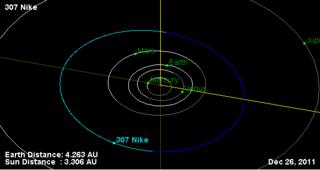Related Research Articles

307 Nike is a sizeable asteroid of the asteroid belt. It was discovered by Auguste Charlois on 5 March 1891 while working at the Nice Observatory. Charlois named it after the Greek goddess of victory, as well as the Greek name for the city where it was discovered. Measurement of the light curve of this asteroid in 2000 indicates a rotation period of 7.902 ± 0.005 hours.

502 Sigune is a minor planet, specifically an asteroid orbiting primarily in the asteroid belt. Like 501 Urhixidur and 500 Selinur, it is named after a character in Friedrich Theodor Vischer's then-bestseller satirical novel Auch Einer.
542 Susanna is a minor planet orbiting the Sun.
581 Tauntonia is a dark Alauda asteroid from the outer region of the asteroid belt, approximately 61 kilometers in diameter.
758 Mancunia is a minor planet orbiting the Sun. It was discovered in 1912 from Johannesburg by H. E. Wood, a Mancunian. This object is orbiting at a distance of 3.19 AU with a period of 5.70 years and an eccentricity (ovalness) of 0.15. The orbital plane is inclined at an angle of 5.61° to the plane of the ecliptic.
871 Amneris is a minor planet orbiting the Sun. It is the namesake of the Amneris family, a subgroup of the Flora family of Main Belt asteroids.
876 Scott is a minor planet orbiting the Sun. For a long time, its name had been falsely attributed to Robert Falcon Scott. In fact, it was named after discoverer Johann Palisa's financial supporter Miss E. Scott.
890 Waltraut is an Eoan asteroid from the outer region of the asteroid belt that was discovered by German astronomer Max Wolf on 11 March 1918. It was named for a character in Richard Wagner's opera, Götterdämmerung.
892 Seeligeria is dark Alauda asteroid from the outer region of the asteroid belt that was discovered by German astronomer Max Wolf on May 31, 1918 in Heidelberg and assigned a preliminary designation of 1918 DR. It was named after German astronomer Hugo Hans von Seeliger.
897 Lysistrata is a minor planet orbiting the Sun that was discovered by German astronomer Max Wolf on August 3, 1918.
899 Jokaste is a minor planet orbiting the Sun. It was one of five minor planets included in the 1993 study, Transition Comets -- UV Search for OH Emissions in Asteroids, which was research involving amateur astronomers who were permitted to make use of the Hubble Space Telescope. Not to be confused with Iocaste, a moon of Jupiter.
903 Nealley is a minor planet orbiting the Sun. The semi-major axis of the orbit of 903 Nealley lies just inside the Hecuba gap, located at 3.27 AU.
905 Universitas is an S-type asteroid orbiting in the Main belt as part of the Flora family. Its diameter is about 21 km and it has an albedo of 0.085. Its rotation period is approximately 14.2 hours.

906 Repsolda is a minor planet orbiting the Sun. It is named for the German astronomer and fireman Johann Georg Repsold (1770–1830), who founded and ran Hamburg Observatory.
1918 Aiguillon provisional designation 1968 UA, is a dark asteroid from the outer region of the asteroid belt, approximately 20 kilometers in diameter.
6144 Kondojiro (1994 EQ3) is an asteroid discovered on 14 March 1994 by Kin Endate and Kazuro Watanabe at the Kitami Observatory in eastern Hokkaidō, Japan. It is named after Jiro Kondo, a Japanese Egyptologist and professor of archaeology at Waseda University.
655 Briseïs is a minor planet orbiting the Sun.
(78799) 2002 XW93, provisional designation 2002 XW93, is a trans-Neptunian object and centaur from the outer Solar System, approximately 500–600 kilometers (300–400 mi) in diameter. It was discovered on 10 December 2002, by astronomers at the Palomar Observatory in California.
(458732) 2011 MD5 is an Apollo near-Earth asteroid around 1.2 kilometers (0.75 miles) in diameter. It is the largest asteroid known to have passed closer than the Moon. On 17 September 1918 the asteroid passed 0.00234 AU (350 thousand km; 0.91 LD) from Earth with a peak apparent magnitude of around 8.4. The 1918 close approach distance is known with an accuracy of roughly ±120 km. The asteroid had come to opposition (opposite the Sun in the sky) on 9 August 1918 at magnitude 16.
2021 LL37 is a large trans-Neptunian object in the scattered disc, around 600 kilometres (370 miles) in diameter. It was discovered on 12 June 2021, by American astronomers Scott Sheppard and Chad Trujillo using Cerro Tololo Inter-American Observatory's Dark Energy Camera in Chile, and announced on 31 May 2022. It was 73.9 astronomical units from the Sun when it was discovered, making it one of the most distant known Solar System objects from the Sun as of May 2022. It has been identified in precovery images from as far back as 28 April 2014.
References
- ↑ "902 Probitas (1918 EJ)". JPL Small-Body Database . NASA/Jet Propulsion Laboratory . Retrieved 2 May 2016.
- ↑ Lutz D. Schmadel (2003). Dictionary of Minor Planet Names. Springer Science & Business Media. p. 81. ISBN 978-3-540-00238-3.